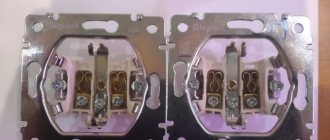The fact that protective “earth” is vital during the operation and maintenance of electrical installations is not subject to discussion. In addition to the mandatory compliance with the requirements of the “Rules for the Construction of Electrical Installations” (PUE), the presence of “earth” protects against electric shock and protects electrical installations from breakdowns associated with interruptions in the power supply.
When commissioning and carrying out repair work on equipment that is temporarily out of service, it often becomes necessary to disconnect the working grounding bus. How to ensure work safety in this case? It is required to install portable grounding.
What is it and why is it called temporary (portable)
The equipment is a type of protective device that ensures safe operation in connected electrical installations. In addition, portable grounding can (or rather, should) be used when performing work in the field: at temporary facilities that do not have a regular connection to the ground. For example, when carrying out welding work in an area where there is no power supply and the site is not equipped in accordance with the Electrical Installation Rules. In this case, both generating and operating equipment are grounded.
The temporary grounding kit is a set of flexible copper conductors (cable without insulation). At the ends of the conductors there are clamps with permanent fixation: like clamps.
Typically, the conductors are connected into three connected lines (for three-phase equipment). When the phases are shorted to each other, the likelihood of the protection tripping increases if voltage is accidentally applied to the line. Clamps that are connected to the power contacts are equipped with insulating rods (when working with voltages over 1000 volts). If during connection the bus is energized, electric shock will not occur.
There are also kits for single-phase electrical installations, consisting of one conductor with clamps at the ends.
Installation of portable grounding is provided in cases where the area taken out for repair is completely disconnected from any cable lines, including the “earth” bus. If voltage is accidentally applied (and during repairs this is quite possible), the device will provide a short circuit to the physical ground and trigger the circuit breaker.
Important! Using portable grounding without protective equipment (fuses, circuit breakers) on the supply line is pointless and dangerous. In the event of a short circuit to ground, primary protection of personnel will be provided, but the power cable and electrical installation may catch fire. The grounding cable may also burn out under prolonged exposure to electrical current, and workers will be shocked by uncontrolled voltage.
Another function of portable grounding is protection against induced voltage. After de-energizing the electrical installation, induced currents may arise on the power cable from nearby power lines. In the normal state, this is prevented by the working “ground”.
Operating principle of the charger
The key principle of grounding is to reduce the voltage potential of a point that comes into contact with live parts until it is safe for people to do so. When dangerous voltage reaches the surface of the equipment, the potential of the ground electrode, which is closest to zero, must be transferred to this very point, which creates a safe and comfortable working environment. After the time has elapsed, the automatic device that protects against electrical leakage is activated. The supply voltage line is deactivated, eliminating the emergency situation.
The manufacturing process of grounding devices requires compliance with some special conditions that will ensure reliability and contact of soil particles with metal surfaces. Electrical conductivity can be increased by immersing a metal grounding structure into the ground, and creating a zone of maximum conductivity around it. This conductivity can be increased by direct chemical action on the earth, for example with salt.
All of the above methods are capable of ensuring reliable movement of electricity into the ground along the grounded base of protective structures. In addition to providing intentional fusion between the frame of electrical equipment and the grounded mechanism, the above method can be used in critical phase-to-ground fault situations.
What are the requirements for the equipment?
- The conductors must be solid throughout the entire length between the terminals, without splices and pebbles (loop-like curls formed by twisting).
- The use of insulated wires is prohibited! It is difficult to control possible damage to the current-carrying conductor under the sheath.
- The cable cross-section is the same along its entire length. For electrical installations up to 1000 V, not less than 16 mm², above 1000 V - 25 mm².
- The length of the conductors is selected in such a way that it is possible to connect the grounding bus and grounded areas without tension on the cable. After connection, it should not be suspended (with the exception of grounding points located at a significant height: for example, power lines).
- The wires must withstand dynamic tensile loads, and not heat up to the melting temperature when a short circuit current flows (at least until the protective devices are triggered to open the power lines). The cross-section of the wire according to the short circuit parameters can be calculated independently using the formula: where Is is the short circuit current, and tprotection is the maximum possible response time of the emergency power cut-off machine.
- The length of the insulating rods must ensure the safe application of clamps without the operator approaching (let alone touching) potentially dangerous live busbars.
- The clamps must provide a reliable connection and be screw tightened (spring pliers are not acceptable). The material, when the temperature rises during the short circuit cycle, should not lose strength and form scale at the point of contact. When tightening the clamp with operating force, deformation should not lead to poor contact.
- The connection of the clamps to the conductors is made by crimping or welding. Connection using a nut is allowed, after which it is necessary to solder the contact point with refractory solder. Connection by soldering alone is prohibited, since at high temperatures the solder may melt and the ground electrode may be disconnected.
The requirements for portable grounding, like the rules of the road, are written in blood. Therefore, their compliance is not simply a formal execution of the PUE. This is people's life and health.
Calculation of cross-section for PZ
The minimum cross-section of the grounding conductor is determined by the formula:
Smin = (Ik.z.*√t)/C
- I short circuit – maximum current value during a short circuit;
- √t – the longest response time of the main protective devices to disconnect a short circuit;
- C is the calculated coefficient, which reflects the change in the resistance of the material under the influence of heat.
The longest time to disconnect a short circuit is taken to be the total value of the following indicators:
- activation time of the main protection;
- response time of automatic restart (reclose);
- duration of machine shutdown.
The calculated value of I short circuit depends on the type of neutral of the electrical network. With a grounded neutral, the value of single-phase short circuit current is used, with an isolated neutral - three-phase.
Procedure for installing temporary grounding
Grounding is installed on the side of the current-carrying busbars from which voltage can be supplied. Between the connection point and the repair work area there should be no converting devices with galvanic isolation (transformers, voltage multipliers, stabilizers, etc.).
The operator performing the portable grounding must wear protective equipment: insulating boots, gloves, and have a protective transparent mask on his face (from possible sparking). It is recommended to use dielectric mats or footrests.
Further work is carried out strictly in the specified sequence:
- The central, or common (when working with a three-phase grounding switch) clamp is attached to an existing and tested grounding bus.
- The indicator checks the absence of voltage on the current-carrying bus.
- Immediately after the test, a control touch is made with the clamp to the current-carrying busbar, after which the conductor is securely fastened.
Important! The procedure for applying portable grounding requires at least two people to carry out the work. This is necessary so that in case of electric shock, it is possible to quickly take measures to turn off the power and provide first aid to the victim.
Of course, only qualified personnel are allowed to work.
Grounding connection on equipment with voltages above 1000 V is made using a rod made of durable dielectric. At lower voltages, working with dielectric gloves is allowed.
Increased security
The procedure for installing any portable grounding used in electrical installations requires the mandatory application of efforts to increase the level of safety of working personnel. Timely adoption of all necessary measures reduces to zero the likelihood of accidental supply of dangerous voltage to sections of the line where repair work is being carried out. To this end, the following mandatory actions will need to be taken:
The doors of the switching equipment, through which voltage from the cable input is supplied to this section of the electrical network, are securely locked. Special insulating caps are placed on the contacts of the knife blocks of the switches that supply voltage to the operating network. Warning posters such as “Work on the line” or “Caution - people are working” are posted on the keys of switching devices.
Posters posted on circuit breakers “Do not turn on, work on line”
Knowledge of the main provisions of this document must be checked during the briefing conducted with members of the installation team before the start of restoration work on the power line.
Each member of the electrical installation team must know in what cases and how he is obliged to act in the event of a threat of electric shock. The person who authorizes the team to work has the right to demand from each of its members knowledge of the rules for providing first aid to a victim of an electric shock. In addition, in particularly dangerous areas, in addition to the person responsible for the work, an observer from among the operational personnel is appointed. Its function is to monitor the order of work operations and issue instructions on violations committed during their implementation.
When removing and applying portable grounding, the employee must strictly follow the above procedure. Even if voltage is mistakenly supplied to the network, the worker will not receive an electric shock when the grounding cable clamp is connected.
What to do if there is no standard protective grounding
If work is carried out on an ungrounded (standard) electrical installation, it is necessary to create a temporary grounding loop. For this purpose, the same triangle is organized in accordance with the rules for organizing a protective grounding system. A portable grounding connection is connected to it.
The ground electrode is organized using metal pins, profiles (they are driven in with a sledgehammer), or gimlets. Such devices must have a device for removing them from the ground after completion of work.
Another option for easy installation is a return hammer ground electrode. With its help, you can easily immerse the rod in the ground and remove it back.
Installation of portable grounding on a temporary circuit is carried out according to the same rules as on a stationary protective grounding bus.
Grounding device technologies
There are several ways to make a ground loop.
Most often, two of them are used:
- Modular-pin grounding.
- Traditional grounding.
Modular grounding design
For its construction, rods made of high-quality copper-coated metal are used. They are driven vertically into the ground to a depth of about 1 m, the diameter of the rods is 14 mm. 30 mm threads are cut along the edges of the rod and also coated with copper.
The metal parts of the structure are connected together with brass couplings. They are connected horizontally with steel strips with brass clamps or a set of copper wire is used for this. Also, a connection is made between the grounding loop and the distribution panel. To protect grounding elements from corrosion, the kit includes protective paste.
Traditional grounding
Such a system is made from ferrous metal: strips, pipes, corners. Three metal electrodes are driven in a triangle 3 m into the ground, with an interval of 5 m. Next, the electrodes are connected into a common circuit using a metal strip and electric welding.
Such grounding has several negative properties (for example, the complexity of creating a circuit and corrosion, which destroys the metal of the product), for this reason, in our time, they are trying to use a more advanced method of grounding instead.
Natural grounding elements
Most often, they are used for grounding electrical equipment. Metal elements of various reinforced concrete structures are used as natural grounding conductors, for example, the foundations of substations and power lines and the foundations of buildings.
Additionally, for natural grounding, parts of underground communications made of metal are connected, for example, cable armor and all kinds of pipelines are suitable, sometimes it is permissible to connect ground communications, for example, rail tracks are suitable for this purpose.
Grounding power lines on poles
Portable grounding intended for power lines differs from “ground” options in the presence of long insulated rods. In addition, the working ends are not equipped with screw clamps, but with gripping hooks with clamps.
Since such work is usually carried out in a field where there is no standard protective grounding, portable grounding electrodes are used. They are usually included in the kit.
Taking into account the absence of screw terminals, and, as a result, less reliable contact with the current-carrying wire, duplicate grounding connections are installed: 2-3 sets per high-voltage wire.
Installation is carried out from the ground: that is, the operator stands on the ground, rather than installing grounding from a pole.
Portable grounding rods for power lines are single-phase. To connect grounded wires to each other, the lines are connected on the ground, at the point of connection with a portable ground electrode.
Grounding systems (GS)
According to the main provisions of the PUE, the grounding of electrical installations and working equipment can be organized in several ways, depending on the neutral connection circuit at the transformer substation.
Based on this feature, there are several types of grounding systems, designated in accordance with generally accepted rules. Their classification is based on a combination of the Latin symbols “T” and “N”, which means the transformer neutral grounded at the substation.
The letters “S” and “C” added to this designation are abbreviations from the English words “common” - common gasket and “select” - separate. They indicate the method of organizing the grounding conductor along the entire length of the supply line from the substation to the consumer (in the first case - a combined PEN, and in the second - separate PE and N).
Combined with a hyphen “CS” means that on some part of the route the grounding conductor is combined with the working “zero”, and on the remaining section they are laid separately.
Connection features
When designing and installing any grounding system, the main attention should be paid to ensuring high reliability of bolted joints and welded contacts between its individual components. Since such structures are designed for long-term operation, it is necessary to minimize possible mechanical loads on them, as well as to ensure reliable protection of metal surfaces from corrosion. Since such structures are designed for long-term operation, it is necessary to minimize possible mechanical loads on them, as well as to ensure reliable protection of metal surfaces from corrosion
Since such structures are designed for long-term operation, it is necessary to minimize possible mechanical loads on them, as well as to ensure reliable protection of metal surfaces from corrosion.
When installing protective grounding in home wiring conditions, first of all, it is necessary to decide on the arrangement of supply lines.
The fact is that in old buildings built before 2003, regulatory requirements did not provide for the presence of a separate grounding conductor in the supply circuit. In such houses, on the consumer side (at the distribution panel), there are only 2 wires in the supply wiring - “phase” and “neutral”.
Moreover, the latter is a combined zero working (PE) and zero protective (N) cores and, according to the international standard, is designated as PEN.
To install grounding in such houses, the PEN conductor is deliberately split into two components, after which a separate conductor N is used as a grounding bus.
It is clear that the artificial structure created in this way only partially complies with the requirements of the regulations, since it is not possible to organize repeated grounding in an apartment building.
In modern houses, the supply wiring must have one more (third) core, designed specifically for connecting the grounding wire of electrical equipment and household appliances. In this case, the common conductor PEN is already divided into two separate conductors PE and N.
Tests
To confirm compliance with GOST requirements, portable grounding systems are subjected to the following types of tests:
- acceptance (during the initial check for compliance with established standards);
- periodic (permissible once every five years);
- standard (with design changes).
Portable groundings are considered suitable for use if the following measures are successfully completed:
1. Visual inspection of the integrity of all structural elements.
Includes inspection of clamps, conductor cores, insulating rod, restrictive ring on the rod, anti-corrosion coating, protective insulation and technical documentation.
2. Climatic tests.
The procedure is carried out at negative and positive temperatures. Its value should reach forty-five degrees Celsius, respectively, below and above zero. Portable grounding is exposed to temperature for two hours. If there are no signs of destruction of the protective insulation and plastic elements, the product is considered suitable for use.
3. Determination of the mechanical strength of rods.
This experiment is intended to measure the bending of the PZ rod. The permissible deflection deviation is ten percent relative to the insulating length of the rod used for electrical installations with voltages up to 220 kV. For higher voltage levels, a twenty percent deviation is allowed.
To carry out the test, the rod is fixed in a horizontal plane. Securing the end of the rod and the place where the restrictive ring fits. Use a metal ruler to set the level of the rod axis. And according to it, the amount of deflection is calculated.
4. Checking the cross-section of the cores.
To establish the actual cross-section of the portable grounding, it is disassembled into strands. Their number is recorded and the number of conductors in one strand is counted. The diameter of the conductor is measured to determine its cross-section. The resulting calculated value is multiplied by the number of conductors in the strand and by the number of strands.
5. Measurement of thermal and dynamic resistance.
The experiment consists of passing through the finished product the appropriate value of short circuit current from laboratory current sources. The current flow continues until the prototype is completely destroyed. If within three seconds no mechanical damage or cores being thrown from the installation sites were observed, then the sample satisfies thermal and dynamic resistance.
6. Determination of the level of contact resistance.
A microohmmeter is used to measure the resistance at the point where the conductors are connected to the clamp. This indicator should not exceed 600 μOhm.
7. Electrical checks of insulating elements.
The insulating parts of portable grounding are subjected to high-voltage tests.
During operation, mechanical tests of grounding wires are not performed. Rods with metal elements are subject to electrical testing. This procedure is performed every two years.
The product is removed from service if the following defects are found:
- disruption of the connection between the clamp and the conductor;
- traces of metal melting or destruction of grounding conductors;
- the presence of more than five percent breakage of conductor cores.
Protection of electrical appliances
To ensure the required level of protection when working with electrical devices of various types, the following protective measures are possible:
- reliable protection of live parts open to public access;
- strengthening protective insulation by building it up;
- restriction of accessibility to equipment housings.
In addition, reduced voltages can be used for these purposes (if design features allow this).
To avoid unwanted insulation breakdowns and dangerous voltage entering the housings of electrical appliances, the following “classical” methods are used:
- Availability of protective grounding.
- Potential equalization system.
- Additional (reinforced) insulation of live parts.
In some cases, the limitation manifests itself in the fact that such samples of electrical equipment are not allowed to be used in particularly hazardous areas (humid or heavily dusty). If, along with grounding, other methods of protecting people working with devices are used, they should not be mutually exclusive. In other words, their action should not reduce the effectiveness of the protection already existing and operating in this place.
The use of natural grounding elements is allowed only in situations where the likelihood of causing significant damage to underground structures due to the flow of emergency current through them is excluded.
Resistance value
The resistance that grounding provides is the ability of the soil to distribute the electric current that enters it with the help of grounding electrodes. The size is important for portable and stationary devices. It is measured in ohms and depends directly on the soil resistance and the area of contact between the ground electrode and the ground. You can change the area by increasing the depth of the electrode or connecting several short electrodes together. In the latter case, the cross-sectional area increases.
The lower the indicator, the better the work with it. A zero value cannot be achieved under natural conditions, so most often different types of electrical equipment have different norms - from 60 to 0.5 Ohms.
If the grounding connection occurs through the neutral of the transformer, the total resistance should not exceed 4 Ohms. Otherwise, the meaning of its use is lost. If it is necessary to arrange grounding in a private house, the calculation should be based on the fact that in such houses the value does not exceed 30 Ohms.
If you need to install grounding to connect an air terminal, changing the cross-section and length, you should achieve a resistance of no more than 10 Ohms. When grounded, a current source in the form of a transformer or generator should not be connected to surfaces with a resistance exceeding 8 ohms. The permissible value directly depends on the voltage. If the voltage in the transformer is 380, the resistance should be no more than 2 ohms, 220 - no more than 4 ohms, 127 - no more than 8 ohms.
If the equipment is equipped with gas arresters used to protect lines carried through the air, the grounding should not produce a resistance greater than 2 ohms; some equipment allows 4 ohms and has special notes about this.
For telecommunications equipment, the resistance requirements are 2-4 ohms. If a substation designed for 110 kV is used, the grounding resistance should not be higher than 0.5 Ohm.
The resistance standards illustrated above apply to normal soils, the resistivity of which is not higher than 100 Ohm*m. These soils include clayey and loamy soils. For example, sandy surfaces are characterized by a resistivity of 500 Ohm*m, which exceeds the well-known and generally accepted standard by five times.
Inspection frequency
Any electrical equipment has its own service life. For such a protective device, this figure is 8 years. These limits are justified by the risk to workers' livelihoods. When checking, protective structures must be in working order.
According to routine maintenance, there are deadlines for checking grounding equipment. The number of inspections should be once every 6 months. In addition, an external inspection is carried out at least twice during this period.
If these structures provide grounding for medical devices associated with human life, such checks are carried out more often.
Also, if the grounding is transferred to another device, then the inspection and testing will need to be done again. The inspection period also changes and is calculated from the moment of new installation.











